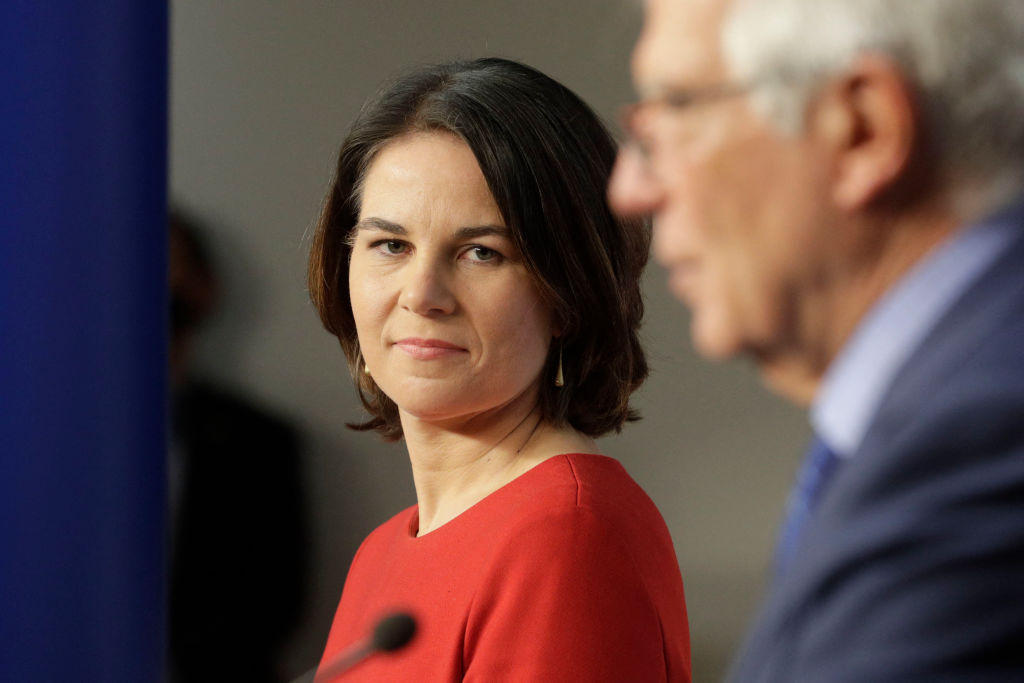
In the spring of 2021, Annalena Baerbock became an unlikely candidate to lead Germany’s chancellery election after experiencing a huge surge in popularity ahead of the vote in September of that year. But after she pledged to block a gas pipeline project between Russia and Europe, the Greens party candidate soon became the target of a vicious campaign on social media.
Suddenly, fake and photoshopped images of a nude Russian model were circulated purporting to be of Baerbock and suggesting that she previously worked as a sex worker. A string of sexist attacks followed, including questions about whether she could balance the responsibilities of chancellorship with being a mother. Her high approval rate quickly plummeted and Baerbock eventually lost the election, coming in third place.
Studies conducted by the German Marshall Fund and the Institute of Strategic Dialogue eventually found that Baerbock had been hit by an especially high amount of disinformation from Russian state-backed sources. Bild, a tabloid in Germany, wrote that NATO specialists even believed that “Moscow [had] pressed the anti-Baerbock button.”

Attacks portraying women in politics as promiscuous or having an unconventional sexual past are often common and effective tactics employed by political opponents. But Lucina Di Meco, co-founder of the online campaign, “#ShePersisted,” said that Baerbock’s example also revealed two other phenomena at play, which she has written about in a new study called “Monetizing Misogyny.” Not only does gendered disinformation lead to the backsliding of women’s rights and democracy as a whole, but the study found that gendered disinformation also becomes a national security threat when foreign actors use it to exploit divisions in society.
More from TIME
Although the term “gendered disinformation” doesn’t have a standard definition, Di Meco, a leading gender equality expert, has described it as the spread of deceptive or inaccurate information or images used against women in public life. A study conducted by Demos in 2020 noted that gendered disinformation isn’t just false information—it also uses “highly emotive and value-laden content to try to undermine its targets,” and ”seeks impact primarily at the political level, though can also cause serious harm at the personal level,” leading to hate campaigns that come with terrifying, and sometimes lethal, consequences for women in politics.
The study examined in-depth case studies in five countries—Brazil, Italy, Hungary, Tunisia, and India—over the period of two years and interviewed over 50 women leaders to look at how social media was weaponized as propaganda by authoritarians and illiberal actors. Below, some key takeaways from the study on how gendered disinformation undermines democracies around the world.
When it comes to disinformation, women are more targeted than men
During the U.S. national elections in 2020, women candidates were attacked online more often than men—particularly on Twitter, and sometimes by up to three times as much. One example of this targeting was a coordinated campaign of disinformation and harassment attempting to malign Kamala Harris’ record as a prosecutor.
The same was true in Finland, where Di Meco observed that female ministers received a disproportionate number of abusive messages despite operating in one of the most gender-egalitarian countries in the world. At times, the disinformation also had tragic consequences, as in the case of Jo Cox, a British Member of Parliament, who was killed by a far-right activist after having been a victim of repeated online harassment and threats.

Marginalized women are targeted more viciously
Oftentimes, these attacks are worse on women who came from marginalized communities: in the case of India, Dalit and Christian women experienced more targeted disinformation campaigns. Angellica Aribam—who hails from the northeastern Indian state of Manipur and founded a foundation that works to expand women’s political participation called Femme First—told Di Meco that her online trolling was far worse because of a perception that women from the northeast region of India are “easy” and “characterless.” “Because of my intersectional marginal identity I have been targeted so much,” Aribam said.
Di Meco believes this is because in many instances, “just by the fact of being themselves, these women represent a goal of inclusive democracies, democracies that are multicultural or multi-religious,” and therefore, a threat to autocratic leaders.
Gendered disinformation is an “early warning system” for democracies
In recent years, gendered disinformation has presented a national security problem as autocratic leaders have deployed misogyny as a way to connect with voters who feel threatened by women’s and minority rights.
A notable example of this is the number of Russian campaigns that attempted to undermine foreign elections in countries including the U.S., Belarus, Ukraine, and Germany. Since the invasion of Ukraine, Di Meco’s research has also identified Russian misinformation, often linked to anti-gender narratives, visibly spreading on social media in Italy and Hungary. In Italy, social media accounts that had been active in spreading hate campaigns against Italian women in politics visibly aligned themselves in support of Russian president Vladimir Putin. Similarly, Tunisia saw inauthentic behavior on Facebook originating from Russia and Israel targeting voters to influence election outcomes.
“Misogyny in the online virtual world is an accelerating and powerful means of curating the digital political sphere,” the writer, Nitasha Kaul, says in the report. And because these online subcultures are especially prominent among the followers of right-wing and far-right political leaders, gendered disinformation becomes the central tool used against women opposition leaders by autocrats to undermine democracy.
Digital platforms are failing to protect women
Di Meco’s study found that digital platforms have “overwhelmingly failed at protecting women.” In all the case studies, researchers looked at whether civil society organizations had engaged with the main digital platforms where the disinformation was spreading, including Twitter and Facebook, to see what kind of responses the women had gotten.
“Over and over, we heard that when they tried to engage digital platforms to get better protections, those platforms really turned a blind eye at best,” says Di Meco.
Moreover, the use of algorithms, trending topics, and coordinated sharing tools have even boosted and amplified harmful narratives against women by making content go viral across channels. These efforts serve commercial interests for social media platforms at the expense of escalating attacks against women.
Although many social media platforms have begun to finance research and initiatives around such topics in order to find solutions, Di Meco says that so far, they have mostly been “cosmetic.” For example, many organizations have proposed improving the digital literacy of users.
“Sure, digital literacy is important,” says Di Meco, “But the pace of the problem is so big that we just don’t have the time to create an initiative to make sure the whole world becomes digitally literate,” she says.
More Must-Reads from TIME
- L.A. Fires Show Reality of 1.5°C of Warming
- Home Losses From L.A. Fires Hasten ‘An Uninsurable Future’
- The Women Refusing to Participate in Trump’s Economy
- Bad Bunny On Heartbreak and New Album
- How to Dress Warmly for Cold Weather
- We’re Lucky to Have Been Alive in the Age of David Lynch
- The Motivational Trick That Makes You Exercise Harder
- Column: No One Won The War in Gaza
Write to Astha Rajvanshi at astha.rajvanshi@time.com